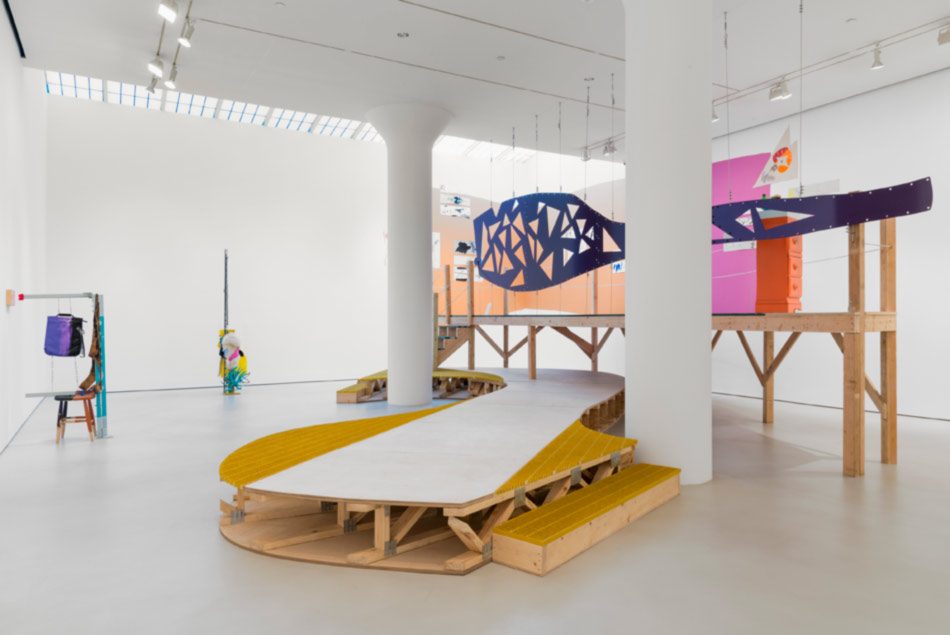"Feeling gravity’s pull: Jessica Stockholder’s stacked works at Mitchell-Innes & Nash"
Wallpaper*
31 August, 2016
Click here to view online.
Wallpaper*
31 August, 2016
Click here to view online.

Creased, tied, folded, pierced, draped and bound: the repertoire of operations that Jessica Stockholder applies in her handling of found and manufactured materials is seemingly infinite.
Blurring the boundaries between painting, sculpture and architecture, Stockholder’s current exhibition at Mitchell-Innes & Nash emphasises process, form, and, above all, gravity. This is apparent in installations such as Sale A Way or Security Detail that feature slouched and hanging components.
However, the force is most integral to the artist’s ongoing series of Assists – sculptures that cannot stand upright without the support of a given ’base’. Assist: Smoke and Mirrors, for instance – comprised of a web of copper wire, tarp and hardware parts – is buttressed by an upholstered chair; in a future iteration, it may instead come to lean on another sculpture or object. In the Assists, each component’s mass, orientation and weight affect the stability of adjacent elements. Such works, perhaps, reflect the possibilities of both vulnerability and mutual dependence within our personal and civic lives.
The symbiosis of individual parts within a given sculpture mirrors that which binds all works in the exhibition. For instance, viewers may walk on, and interact with, the titular installation, The Guests All Crowded Into the Dining Room: a constructed, multi-level environment reminiscent of a playground, a stage, or temporary scaffolding. The piece is also a ’base’ for yet another sculpture, Shadows Over, which itself comprises a pedestal on which shells and small objects are displayed.
From that vantage-point ’upstairs’, one can peruse a mini-exhibit of line drawings that illustrate the mechanics of Stockholder’s constructions. Like film strips or flipbooks, they depict scribbled forms fracturing into ever-smaller lines and dashes, or a succession of repeated shapes toppling like dominoes. Stockholder seems to merge a formalist awareness of the relationships of part to whole in the art studio with a subtle nod to the individual’s relationship to society, the environment and the material world.
Blurring the boundaries between painting, sculpture and architecture, Stockholder’s current exhibition at Mitchell-Innes & Nash emphasises process, form, and, above all, gravity. This is apparent in installations such as Sale A Way or Security Detail that feature slouched and hanging components.
However, the force is most integral to the artist’s ongoing series of Assists – sculptures that cannot stand upright without the support of a given ’base’. Assist: Smoke and Mirrors, for instance – comprised of a web of copper wire, tarp and hardware parts – is buttressed by an upholstered chair; in a future iteration, it may instead come to lean on another sculpture or object. In the Assists, each component’s mass, orientation and weight affect the stability of adjacent elements. Such works, perhaps, reflect the possibilities of both vulnerability and mutual dependence within our personal and civic lives.
The symbiosis of individual parts within a given sculpture mirrors that which binds all works in the exhibition. For instance, viewers may walk on, and interact with, the titular installation, The Guests All Crowded Into the Dining Room: a constructed, multi-level environment reminiscent of a playground, a stage, or temporary scaffolding. The piece is also a ’base’ for yet another sculpture, Shadows Over, which itself comprises a pedestal on which shells and small objects are displayed.
From that vantage-point ’upstairs’, one can peruse a mini-exhibit of line drawings that illustrate the mechanics of Stockholder’s constructions. Like film strips or flipbooks, they depict scribbled forms fracturing into ever-smaller lines and dashes, or a succession of repeated shapes toppling like dominoes. Stockholder seems to merge a formalist awareness of the relationships of part to whole in the art studio with a subtle nod to the individual’s relationship to society, the environment and the material world.